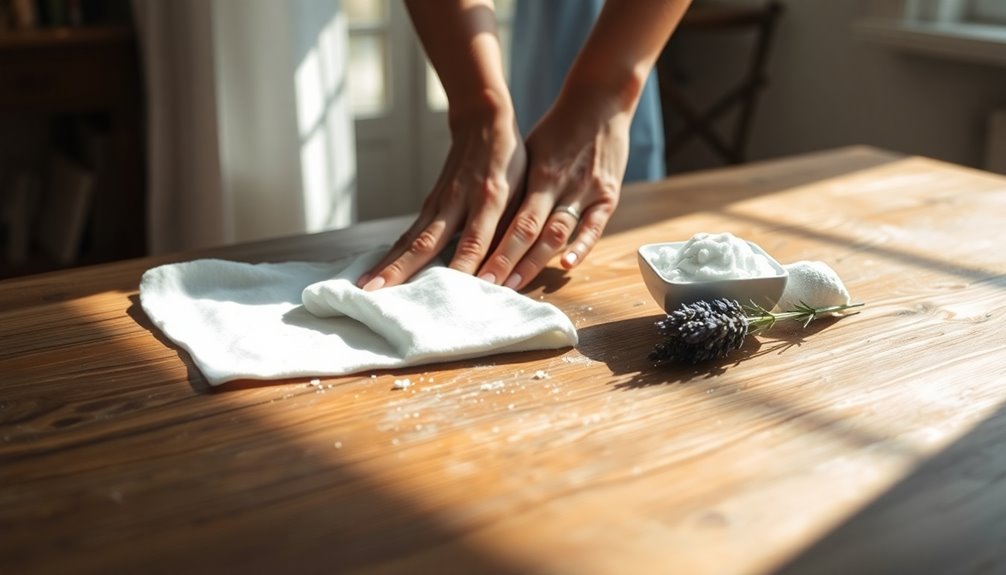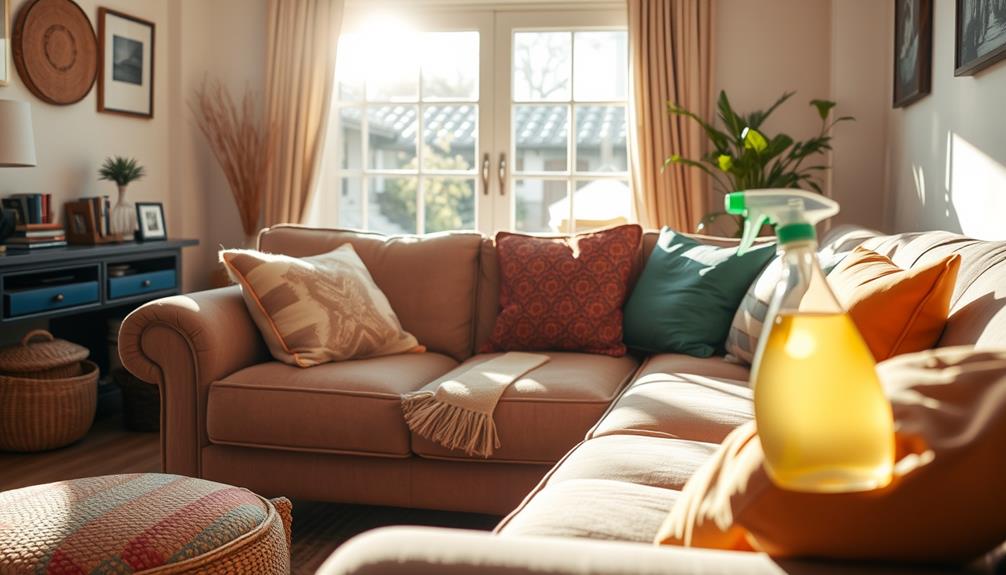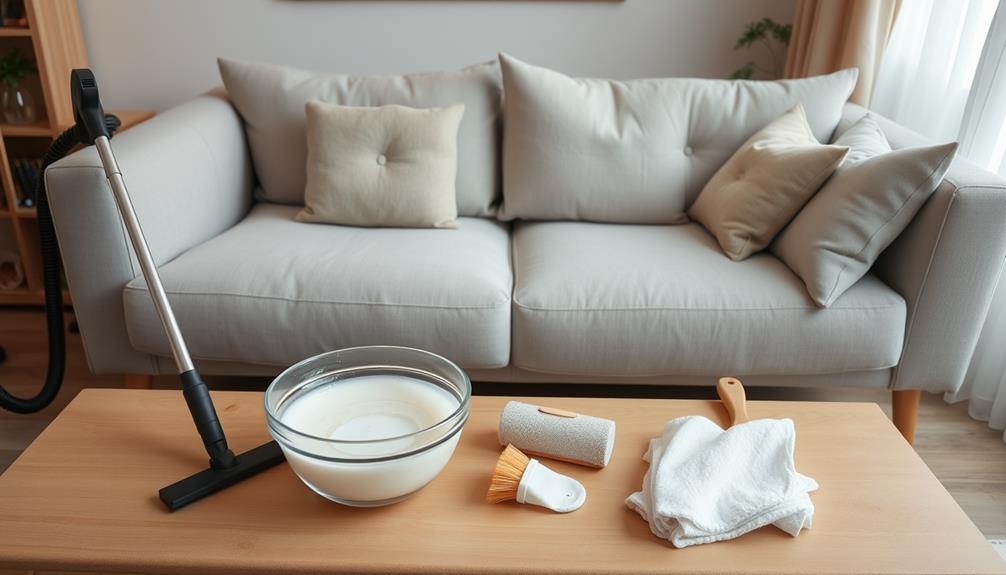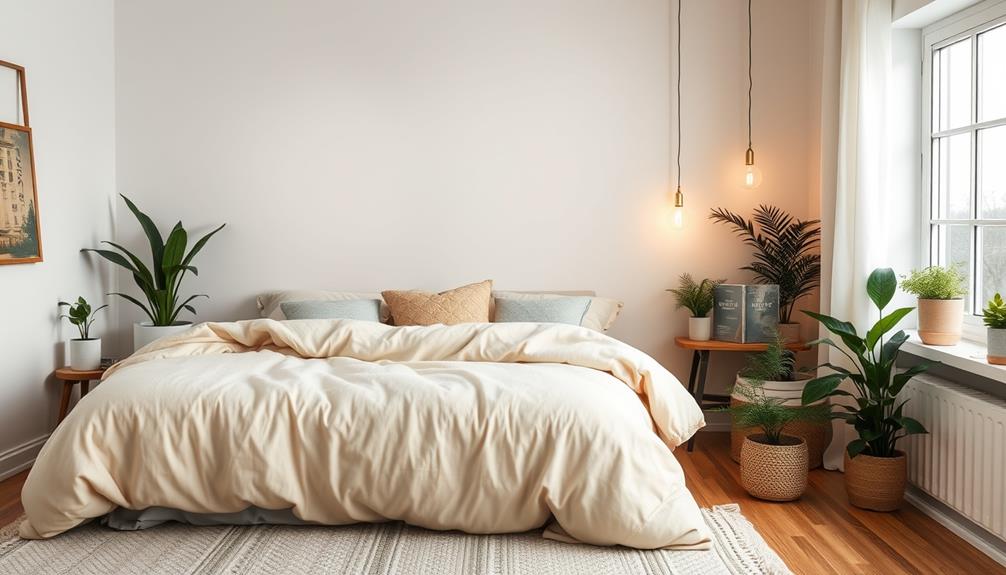To remove musty smells from wood furniture, start by thoroughly cleaning it. Use a vacuum with a soft brush to eliminate dust, then wipe down surfaces using a mix of Murphy’s Oil Soap and warm water. For tougher odors, try a solution of white vinegar and water. To absorb lingering smells, place bowls of baking soda or activated charcoal inside drawers and compartments. Ensure proper ventilation by moving furniture outdoors to dry in the sun or using a dehumidifier. Regular maintenance is key to preventing musty odors from returning, and there’s more you can do to keep your furniture fresh. Additionally, consider using essential oils, such as lavender or tea tree oil, which not only provide a pleasant scent but also have antibacterial properties. If you’re also concerned about pet-related smells, research specific methods on how to eliminate dog odors from furniture, as these can often be more challenging to tackle. Regularly wash any removable fabric coverings and invest in odor-neutralizing sprays designed for upholstery to maintain a fresh environment.
Key Takeaways
- Clean wood furniture regularly with a mixture of Murphy's Oil Soap and warm water to remove dust and prevent odor buildup.
- Use natural odor absorbers like baking soda or activated charcoal in drawers and shelves to neutralize musty smells.
- Ensure proper ventilation by placing furniture in well-ventilated areas and using fans to circulate air.
- Maintain humidity levels between 40-60% using dehumidifiers to prevent moisture retention and mold growth.
- Inspect for pests and clean hidden areas to eliminate potential odor sources and ensure furniture is stored properly.
Understanding the Causes
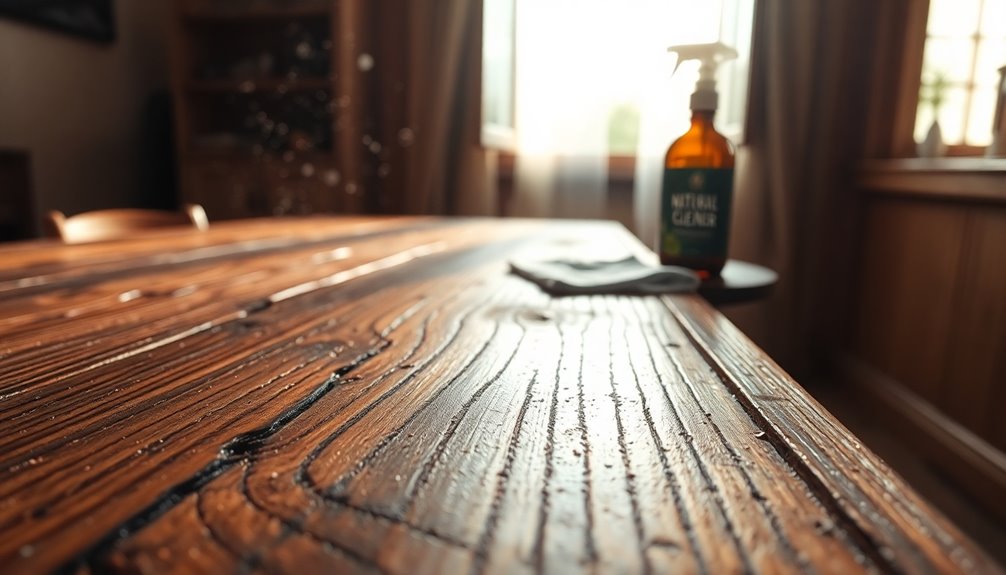
Understanding the causes of musty smells in wood furniture is essential for effective remediation. High humidity levels are a primary culprit, making wood absorb moisture from the environment, leading to odors. When the humidity fluctuates, wood can swell, warp, or crack, worsening the smell. To combat this, consider using a dehumidifier in humid areas to maintain optimal moisture levels. Additionally, utilizing air conditioning can also help control humidity levels within enclosed spaces.
Age plays a significant role too. As wood ages, it naturally breaks down, releasing volatile organic compounds (VOCs) that contribute to unpleasant odors. Antique furniture, in particular, is more susceptible to musty smells due to its age and lack of maintenance. Furthermore, wood-burning emissions can introduce additional VOCs into the environment, exacerbating musty odors in older furniture.
Additionally, dust and dirt accumulate on wood surfaces, trapping moisture and creating a breeding ground for mold. Regularly cleaning your furniture can help prevent this buildup, especially in hidden areas like drawers.
Poor ventilation is another factor. Unventilated spaces, such as attics or basements, lead to moisture buildup and musty odors. Ensuring proper airflow and consistent temperature and humidity levels can help mitigate these issues. By understanding these causes, you can take steps to eliminate musty smells from your wood furniture effectively.
Cleaning the Wood Furniture
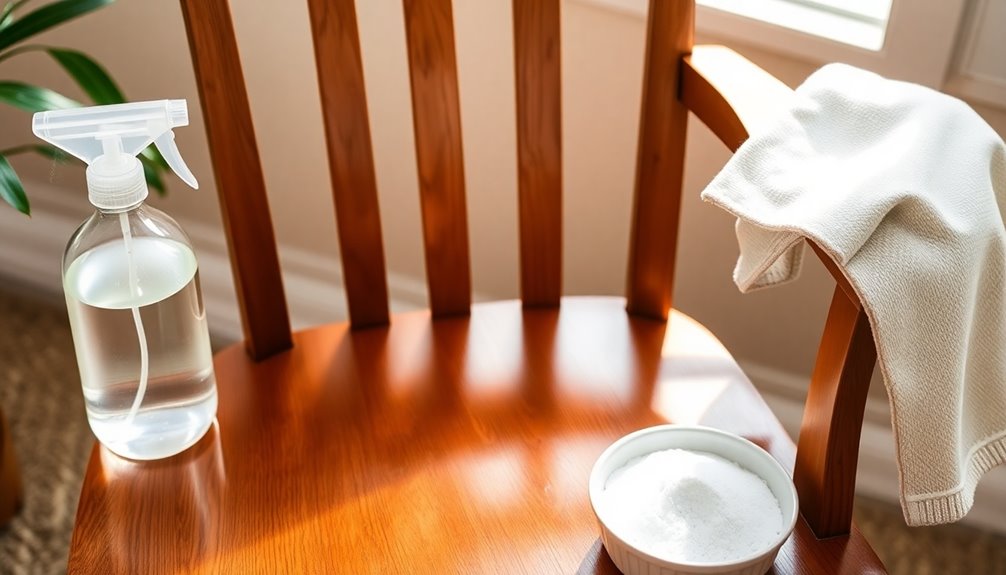
Once you've identified the causes of musty smells in your wood furniture, it's time to tackle the cleaning process. Start by using a dry cloth or a vacuum with a soft brush attachment to remove any loose dust and dirt from the surface. If your furniture has a clear finish, test a small, inconspicuous area with mineral spirits to ensure it won't damage the finish. For deeper cleaning, dampen a cotton cloth with mineral spirits and clean hard-to-reach areas, especially around intricate carvings.
For general cleaning, mix 1/2 cup of Murphy's Oil Soap with a gallon of warm water, using a clean soft cloth to wipe the furniture down. Make sure to dry it with another clean cloth afterward. Natural wood finishes are gaining popularity, making it essential to ensure any cleaning method is suitable for the specific finish of your furniture to avoid further damage. Avoid detergents, as they can leave a damaging film.
If you encounter stubborn stains, create a paste from baking soda and water, apply it gently, and wipe off with a damp cloth. For unfinished furniture, just use a dry cloth to remove soil. Always ensure any cleaning method is suitable for the specific finish of your furniture to avoid further damage.
Using Odor-Absorbing Substances
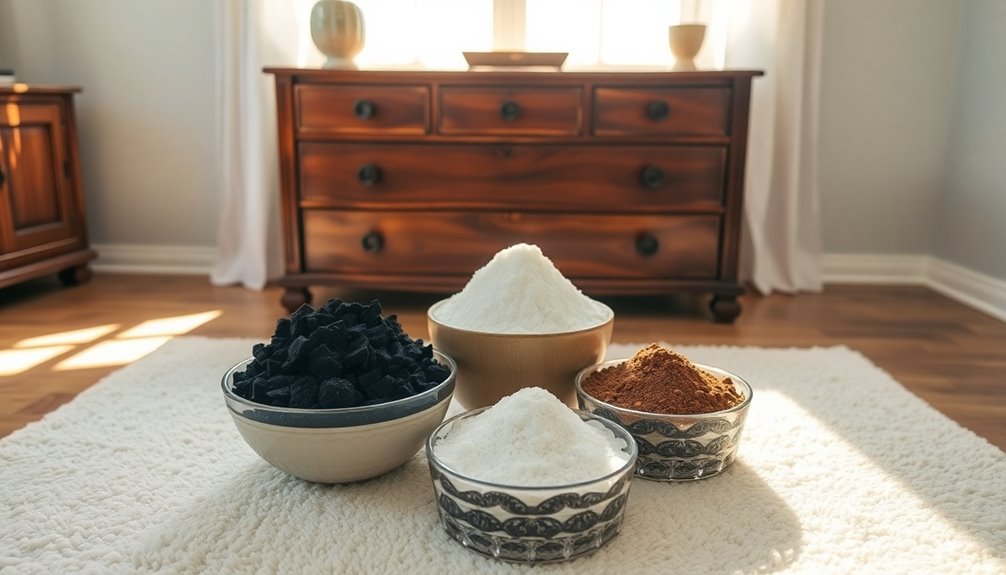
To effectively eliminate musty odors from your wood furniture, you can turn to several natural odor-absorbing substances. Baking soda works wonders for organic smells. Simply sprinkle it over the furniture's surface and let it sit for a few hours or up to 24 hours. For deeper odors, place a bowl of baking soda inside closed spaces like drawers. Afterward, just vacuum or wipe away the residue.
Activated charcoal is another powerful option. It absorbs a range of odors, including musty smells. Place bowls of activated charcoal inside drawers or on shelves, leaving them for a few days to neutralize the scent. You can also use breathable bags for better results. Wood as a porous material absorbs odors easily, making it essential to use these methods to combat mustiness effectively.
White vinegar is effective as a natural deodorizer. Mix equal parts of vinegar and water in a spray bottle, lightly spray it on the surface, and wipe clean with a rag. The vinegar smell dissipates while breaking down unpleasant odors.
Additionally, consider using coffee grounds, kitty litter, or even vodka in bowls placed inside the furniture. Allow these substances to sit for several days for optimal odor absorption, and feel free to combine them for enhanced effectiveness.
Drying and Dehumidifying
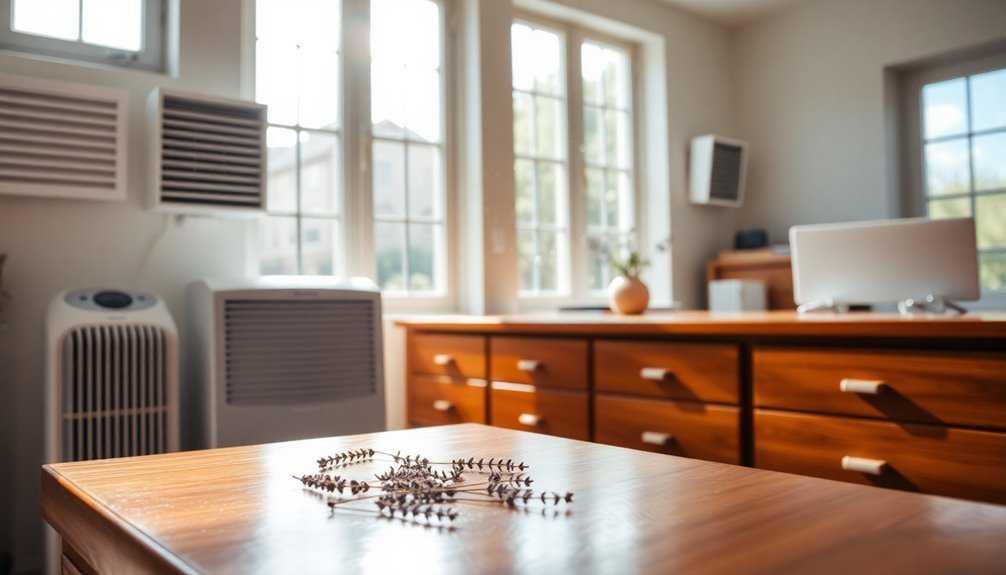
Effective drying and dehumidifying are crucial steps in eliminating musty smells from wood furniture. Start by moving your furniture outside to dry under sunlight, if the weather permits. If not, place it in a well-ventilated area, avoiding direct sunlight that could damage the wood or finish. Using fans can help circulate air around the furniture, speeding up the drying process. Make sure to keep the furniture away from shaded or damp areas. Additionally, humid environments can exacerbate odor retention in furniture, so it's important to monitor moisture levels.
To further reduce moisture, consider using a dehumidifier in the same room as your furniture. Run it for several hours over a few days, especially in smaller enclosed spaces for more effective moisture removal. Monitor the humidity levels to ensure they stay low, and combine the dehumidifier with fan circulation for optimal results.
Ensure the room has good airflow by opening windows and doors to allow fresh air to circulate. Air conditioning can also help maintain a low moisture environment. Avoid placing your furniture in unventilated areas like attics or basements, and use breathable materials around it to prevent moisture buildup. Following these steps will significantly help in removing that musty odor.
Stripping and Sanding
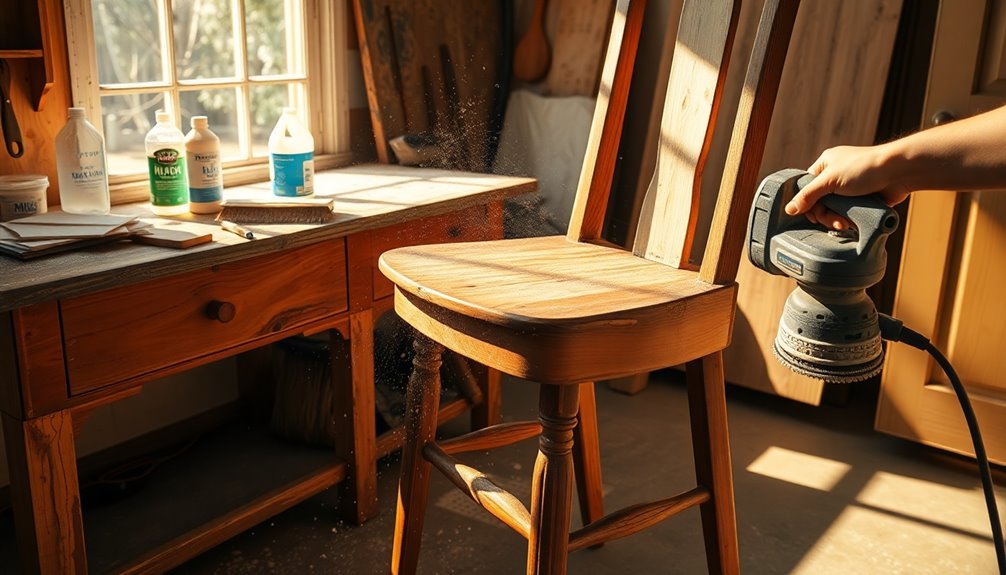
After ensuring your wood furniture is dry and moisture-free, the next step in removing that musty smell is stripping and sanding. Start by stripping the old finish, which can trap odors. You can use a chemical stripper or sandpaper to effectively remove the finish. Make sure to wear safety gloves and goggles, and work in a well-ventilated area. This will expose the natural wood, allowing it to breathe and potentially reducing the odor.
Once the finish is stripped, move on to sanding the wood surface. Use fine-grit sandpaper and sand along the wood grain to avoid scratches. Sand until the surface feels smooth and any remnants of the old finish are gone. After sanding, wipe away the dust and debris with a clean cloth.
To tackle any remaining odors, place substances like baking soda, vinegar, or charcoal inside drawers or on surfaces and let them sit for several days. Additionally, consider that environmental factors like humidity can exacerbate odor absorption, so maintaining a dry environment is crucial. You can also create a deodorizing spray using essential oils mixed with water and vinegar. Repeat this process as necessary until the musty smell is fully eliminated.
Preventing Future Musty Smells
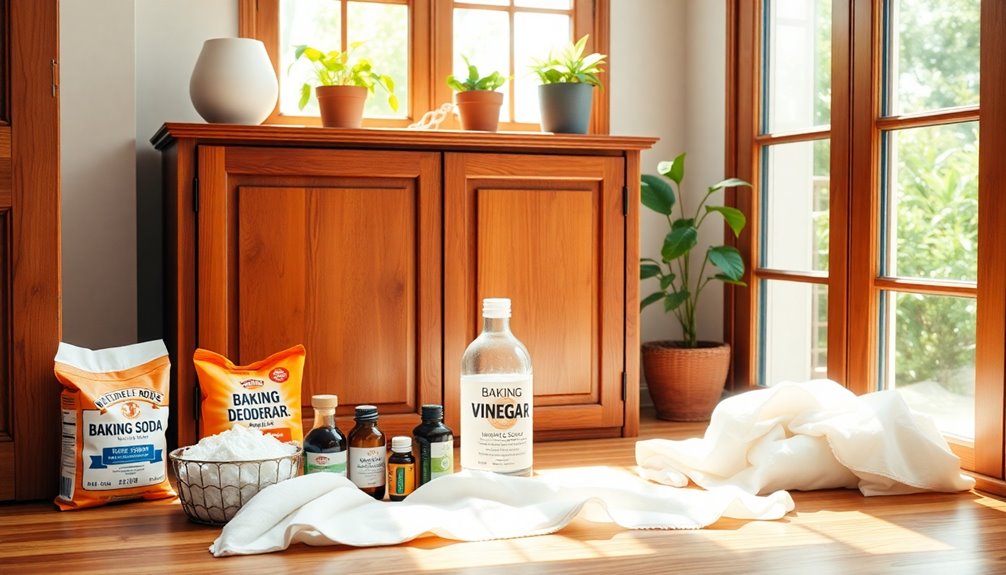
Preventing future musty smells in wood furniture starts with maintaining optimal humidity levels in your home. Aim for a relative humidity between 40-60% to prevent the wood from swelling or shrinking. Consider using whole-house humidifiers and dehumidifiers for consistent control. Avoid extreme fluctuations in moisture, and consult with humidity control professionals to find the best settings for your space.
Regular cleaning and disinfecting are equally important. Use soap and water or specialized wood cleaners, and incorporate white vinegar solutions to kill odor-causing bacteria and mold. Don't forget to sanitize hidden areas like the undersides of surfaces and inside drawers.
Natural odor absorbers can also help. Place coffee grounds, baking soda, or clay-based kitty litter in drawers to absorb musty smells. Charcoal can be effective as well, so consider using it in closed furniture drawers. Additionally, ensure you regularly check for pests to avoid potential odors that could arise from infestations.
Finally, store your wood furniture in well-ventilated areas and avoid damp environments like basements. Apply essential oils such as cedar or tea tree oil to prevent mold growth while ensuring good airflow around the furniture to keep moisture at bay. Regularly inspect for signs of moisture damage, and you'll keep musty smells at bay.
Frequently Asked Questions
Can Musty Smells Harm My Health or Cause Allergies?
Yes, musty smells can harm your health and trigger allergies. When you breathe in mold spores, you might experience respiratory issues like coughing or wheezing, especially if you have asthma. You could also develop allergy-like symptoms such as itchy eyes and skin rashes. If you have chronic lung conditions or a weakened immune system, the risks are even higher, potentially leading to infections. It's important to address musty odors to protect your well-being.
How Can I Tell if My Furniture Is Infested With Mold?
To tell if your furniture is infested with mold, start by looking for visible mold growth or discoloration on surfaces. Check for any unusual textures, like fuzzy patches. Pay attention to water damage signs, such as stains or warping. Trust your sense of smell—if you detect a musty odor that lingers, it could indicate mold. Regularly inspect your furniture, especially in humid areas, to catch any issues early.
Are There Any Natural Remedies for Musty Smells in Wood Furniture?
Yes, there are several natural remedies for musty smells in wood furniture. You can mix equal parts of white vinegar and water in a spray bottle, lightly mist the surface, and wipe it down. Placing your furniture in sunlight and fresh air helps too, as it kills bacteria. Additionally, using baking soda or activated charcoal can absorb odors. Essential oils mixed with vinegar can also freshen up your furniture naturally.
How Often Should I Clean My Wood Furniture to Prevent Odors?
You should clean your wood furniture regularly to prevent odors. Dust it weekly with a microfiber cloth to keep dirt and debris at bay. Use gentle wood cleaners every few weeks, and dry the surfaces thoroughly after cleaning. Additionally, polish your furniture periodically to maintain the finish. This routine not only keeps your furniture looking great but also helps avoid any buildup that could lead to unpleasant smells over time.
Will Painting Over Musty Wood Eliminate the Smell Completely?
Painting over musty wood won't eliminate the smell completely. You'll find that the underlying odors can seep through the paint over time if you haven't cleaned and dried the wood properly first. Musty smells often come from mold or mildew, which need to be treated before you paint. To ensure lasting freshness, focus on cleaning, drying, and possibly stripping the wood before applying any paint. Otherwise, the musty scent will likely return.
Conclusion
By following these steps, you can effectively remove musty smells from your wood furniture and keep it fresh. Regular cleaning, using odor-absorbing substances, and ensuring proper drying can make a world of difference. If the smell persists, don't hesitate to strip and sand the wood to restore its natural beauty. Most importantly, take preventive measures to keep your furniture smelling great in the future. With a little effort, you'll enjoy your wood pieces without any unpleasant odors!
